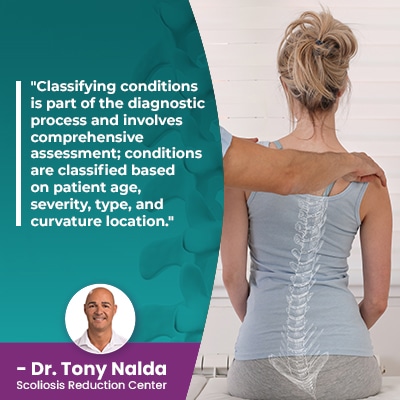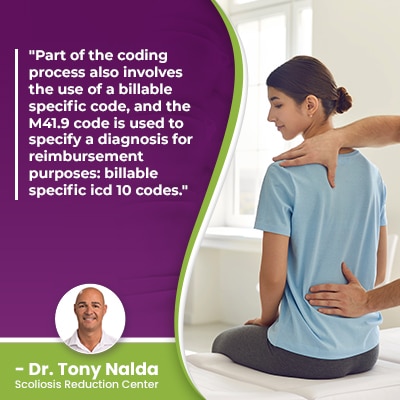What Are The ICD-10 Codes for Scoliosis?

When scoliosis is diagnosed, there are a number of condition-parameters that have to be met, and part of the diagnostic process involves further classifying conditions based on key patient/condition variables that shape the crafting and customization of potentially-effective treatment plans.
When the United States government and the American Medical Association developed a system for diagnostic coding of diseases/conditions, the acronym ICD-10 was born: International Classification of Disease. The coding system helps streamline the diagnostic and treatment process.
Let's start with how scoliosis is diagnosed and classified, before exploring the condition's specific icd 10 codes.
Table of Contents
Diagnosing Scoliosis
There are a number of spinal conditions that involve a loss of its healthy curves and a number of specifics that can indicate a diagnosis of scoliosis.
Scoliosis developing means an unnatural spinal curvature with rotation has developed, making it a complex 3-dimensional condition as the spine's unnatural lateral curvature both bends and twists.
In addition, scoliosis is a progressive condition, meaning its very nature is to get worse over time, and this is why how a diagnosis of scoliosis is responded to with treatment is so important.
While I can give no treatment guarantees, the earlier in a condition's progressive line it's diagnosed and treated, the more likely the spine is to respond positively.
Scoliosis ranges widely in severity from mild to moderate and severe to very severe, and severity is one of the condition's key classification-points.
 Classifying conditions is part of the diagnostic process and involves comprehensive assessment; conditions are classified based on patient age, severity, type, and curvature location.
Classifying conditions is part of the diagnostic process and involves comprehensive assessment; conditions are classified based on patient age, severity, type, and curvature location.
Patient Age
Patient age is important not only because it indicates a patient's overall health, but also because it can contribute to a condition's rate of progression and whether or not it's painful.
Scoliosis affects all ages, but the most-prevalent type of scoliosis is adolescent idiopathic scoliosis, diagnosed between the ages of 10 and 18, but it does also affect adults.
Scoliosis is diagnosed in babies as congenital scoliosis, infantile idiopathic scoliosis in infants between the ages of 6 months and 3 years, juvenile idiopathic scoliosis between the ages of 3 and 10, adolescent idiopathic scoliosis, and adult scoliosis.
Patient age is important because the trigger for scoliosis progression is growth, so young patients who are still growing are at risk for rapid-phase progression, particularly adolescents going through the rapid and unpredictable growth spurts associated with puberty.
Scoliosis becomes a compressive condition once skeletal maturity has been reached, and this is why the condition isn't commonly painful in children, but it is the main symptom in adults.
Condition Severity
Condition severity is determined by a measurement known as Cobb angle, and this is taken during X-ray.
A patient's Cobb angle is measured by drawing lines from the tops and bottoms of the most-tilted vertebrae, and the intersecting angle is expressed in degrees.
The higher the Cobb angle, the more out of alignment the spine is, and the more severe the condition:
- Mild scoliosis: Cobb angle measurement of between 10 and 25 degrees
- Moderate scoliosis: Cobb angle measurement of between 25 and 40 degrees
- Severe scoliosis: Cobb angle measurement of 40+ degrees
- Very-severe scoliosis: Cobb angle measurement of 80+ degrees
Condition severity is a key piece of information that treatment plans are shaped around.
Condition Type
There are many different forms of scoliosis.
Condition type is important because it involves its underlying cause, and 80 percent of known diagnosed scoliosis cases are classified as idiopathic, meaning not clearly associated with a single-known cause; the remaining 20 percent are associated with known causes: neuromuscular scoliosis, degenerative scoliosis, and congenital scoliosis.
A condition's underlying cause has to be the focus of treatment as this is the difference between treating the scoliosis itself, or only addressing its symptoms.
Curvature Location
The spine has three main sections, and scoliosis can develop in any one of them: the cervical region (neck), thoracic region (middle/upper back), and the lumbar region (lower back).
Curvature location is important because it tells us where to concentrate our treatment efforts, as well as indicating the area of the body most likely to be affected; in general, the area of the body located the closest to the affected spinal section is the most likely to feel its direct effects.
For example, with scoliosis lumbar region, sciatica can develop as a related complication due to compression of the sciatic nerve that starts in the lumbar region.
Scoliosis can also develop as a combined scoliosis when it affects multiple sites in more than one spinal section: for example, scoliosis thoracolumbar region that develops in the lower thoracic region and the upper lumbar region.
Idiopathic scoliosis can be classified based on one of many different curvature locations: idiopathic scoliosis lumbar region, idiopathic scoliosis site unspecified, scoliosis lumbar region, idiopathic scoliosis lumbosacral region, other idiopathic scoliosis, idiopathic scoliosis thoracolumbar region, idiopathic scoliosis thoracic region, idiopathic scoliosis cervicothoracic region, idiopathic scoliosis cervical region, adolescent idiopathic scoliosis lumbar, adolescent idiopathic scoliosis thoracolumbar, adolescent idiopathic scoliosis lumbosacral, adolescent idiopathic scoliosis cervical, etc.
Now that we've discussed the main general classification-points, let's move on to exploring the specific icd 10 codes for scoliosis.
ICD 10 Codes for Scoliosis
The condition's ICD 10 codes further classify conditions, so let's take a look at some of the most common; as most scoliosis cases are idiopathic, the idiopathic condition codes are used the most often.
Adolescent idiopathic scoliosis (Code M41.12)
Again, adolescent idiopathic scoliosis is the most prevalent type, and in this age group, uneven shoulders and hips are often the condition's earliest signs.
There are never treatment guarantees, but in conditions that are detected and treated early, there are fewer limits to what can be achieved.
Infantile Idiopathic Scoliosis (Code M41.00)
Infantile idiopathic scoliosis is diagnosed in infants between the ages of 6 months and 3 years.
While some cases of infantile idiopathic scoliosis resolve on their own, there is no way to determine which won't, and which will continue to progress with growth.
Juvenile Idiopathic Scoliosis (Code M41.11)
Juvenile idiopathic scoliosis is diagnosed in children between the ages of 3 and 10, and this is the age group I can make the biggest impact with because they have not yet had their first adolescent pubescent growth spurt.
Additional Idiopathic Scoliosis Conditions (Code M41.2)
Idiopathic scoliosis is the main type to affect all ages, and this code is used to refer to any other conditions that are undetected prior to a patient reaching skeletal maturity, which is generally around 18 years of age.
Cases of adult 'de novo' scoliosis and degenerative scoliosis also fall into this category because they have developed in adulthood with no prior history; these cases most often affect adults over the age of 50.
Congenital Scoliosis (Code Q76.3)
Congenital scoliosis is a rare form affecting approximately 1 in 10,000, and this has a known cause: a congenital bony malformation in the spine that's developed in utero.
Congenital Spinal Deformity (Code Q67.5)
This code is for patients whose congenital scoliosis wasn't caused by a bone malformation, but doesn't fit into another code section, such as postural congenital scoliosis.
Neuromuscular scoliosis (Code M41.4)
Cases of neuromuscular scoliosis are caused by the presence of a larger neuromuscular condition, and the scoliosis develops as a secondary complication.
Some neuromuscular conditions associated with scoliosis include cerebral palsy, spina bifida, and muscular dystrophy.
ICD 10 CM Code M41.9
 Part of the coding process also involves the use of a billable specific code, and the M41.9 code is used to specify a diagnosis for reimbursement purposes: billable specific icd 10 codes.
Part of the coding process also involves the use of a billable specific code, and the M41.9 code is used to specify a diagnosis for reimbursement purposes: billable specific icd 10 codes.
Conclusion
ICD 10 codes for scoliosis are used by the American Medical Association to classify conditions as comprehensively as possible.
There are many more codes than the ones mentioned above, and conditions with scoliosis-related complications such as lung impairment and/or cardiac issues also have their own unique codes.
Developing a system for coding and classifying scoliosis helps maintain a consistent level of care across treatment centers and providers.
Part of the reason scoliosis is so often described as a complex condition to treat is because of its progressive nature, but also because of how highly-variable it can be; no two cases are the same.
The complex nature of scoliosis necessitates the full customization of treatment plans, and when a condition is diagnosed early and responded to with a proactive treatment plan, in many cases, the need for invasive spinal fusion surgery can be prevented.
Scoliosis unspecified is scoliosis that won't be treated as effectively because treatment plans need to be shaped around key patient/condition variables.
Here at the Scoliosis Reduction Center, when it comes to treating idiopathic scoliosis, other secondary scoliosis, other idiopathic scoliosis, and all types of scoliosis in general, being proactive is key because the more a condition is left to progress, the more complex it becomes to treat.
Dr. Tony Nalda
DOCTOR OF CHIROPRACTIC
After receiving an undergraduate degree in psychology and his Doctorate of Chiropractic from Life University, Dr. Nalda settled in Celebration, Florida and proceeded to build one of Central Florida’s most successful chiropractic clinics.
His experience with patients suffering from scoliosis, and the confusion and frustration they faced, led him to seek a specialty in scoliosis care. In 2006 he completed his Intensive Care Certification from CLEAR Institute, a leading scoliosis educational and certification center.
About Dr. Tony Nalda
 Ready to explore scoliosis treatment? Contact Us Now
Ready to explore scoliosis treatment? Contact Us Now





